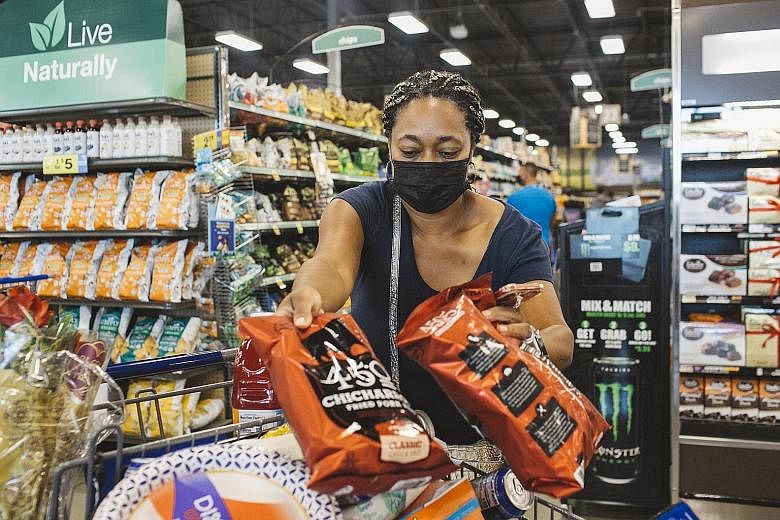NEW YORK • When the coronavirus pandemic struck, even the most enthusiastic cooks had to adjust to a new, more complicated relationship with their kitchens.
For the first time in a generation, Americans began spending more money at the supermarket than at places where someone else made the food. Grocers saw eight years of projected sales growth packed into one month. Shopping trends that were in their infancy were turbocharged.
Here are seven ways the pandemic has changed the way Americans shop for food.
1. Trips are fewer, lists are better
The need to avoid infection has taught people how to get by on fewer trips to the store and to make good shopping lists.
"People now go to the store with purpose," said Mr John Owen, associate director for food and retail of market analysis group Mintel. "The number of trips went way down and the size of the basket went way up in April. We have eased back on that, but not by much."
Before the pandemic, 19 per cent of Americans shopped for food more than three times a week, according to a study by management firm McKinsey & Co. That number had dropped to 10 per cent by June.
2. Online aisles are bustling
A year ago, 81 per cent of shoppers surveyed by Gallup said they never turned to the Internet for groceries. Online shopping was lolling at around 3 per cent of all grocery sales, or about US$1.2 billion (S$1.6 billion), according to a survey by Brick Meets Click/Mercatus.
But in June, online grocery sales in the United States hit US$7.2 billion.
Curbside pick-up, delivery's sibling, has also exploded. Stores are converting carparks to better handle traffic from shoppers who drive by to pick up orders.
3. Orange is the new snack
Produce sales have been riding high since March and are still up 11 per cent from a year earlier, said Mr Joe Watson, vice-president at the Produce Marketing Association. But one item is a real outlier: oranges.
In May, grocers sold 73 per cent more oranges than during the same month last year. Even into July, sales remained 52 per cent higher than a year before.
"Oranges were a surprise, but they are popular from an immunity standpoint," Mr Watson said.
They also last longer than some other fruit, which matters when people are going to the store less often, he said.
4. Redrawing the store
Pandemic shopping has ushered in wider aisles, new methods of sanitation and less-crowded stores. Health concerns have also sped up the growth in payment apps and self-checkout.
Retail giant Walmart is testing a new system that replaces traditional checkout lines with an open plaza ringed by 34 terminals. Shoppers can scan their purchases or ask an employee to do the scanning for them.
5. Choices are shrinking
After decades in which American supermarkets expanded to offer a dizzying selection of products and brands, they are pulling back on variety.
There are no more free samples (a health risk) and fewer speciality promotions. Shoppers, intent on getting in and out quickly, are sticking to items they already know.
Grocers have found that they can still do a brisk business with fewer choices. By reducing choices, stores can more easily surf the ups and downs of the supply chain, which are also limiting what is available.
6. The freezer is hot
Frozen food is another surprise breakout. Sales initially jumped by 94 per cent in March from a year earlier, according to the American Frozen Food Institute.
For some consumers, frozen fruit and vegetables became a less expensive and more reliable alternative to fresh. And then there was a simple reality: Some days it is just easier to pull a meal from the freezer.
7. 'Local' is a bigger lure
The fragility of the supply chain, concerns over health and safety and an appreciation of community have buoyed the movement towards food that is raised or produced locally.
Grocers are teaming up with chefs to sell meal kits. Locally grown produce is selling out quickly. It is all part of a greater awareness of food waste and climate change.
NYTIMES

